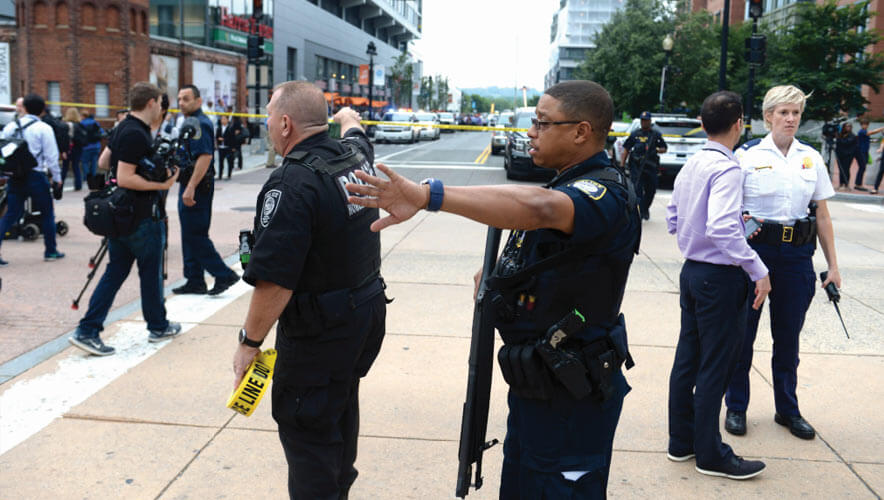A Failure to Communicate
“More than 10 years after the bipartisan 9/11 Commission reported that improvements to interoperable communications at all levels of the government need to be addressed, the National Capital Region continues to face challenges in achieving emergency communications interoperability within and among federal, state, and local agencies, despite substantial investment by the federal government to improve interoperability,” the U.S. Government Accountability Office (GAO) found in a recent report, Emergency Communications: Actions Needed to Better Coordinate Federal Efforts in the National Capital Region.
Crisis response experts say it is critical for first responders and officials to have emergency communications interoperability, or the ability to communicate across agencies and jurisdictions. The lack of interoperability can hamper mission operations and put first responders and the public at risk during a response.
The 9/11 Commission, in its report issued in 2004, examined the communications failures first responders experienced after the 9-11 attacks. The commission recommended allocating radio spectrum to public safety to create an interoperable public safety communications network.
However, the effort to create such a network did not begin in earnest until 2012, when Congress created the First Responder Network Authority (FirstNet) to provide the first nationwide public safety broadband network for public safety entities.
Earlier this year, FirstNet issued a Request for Proposals (RFP) for the deployment of this public safety broadband network. In April, FirstNet officials indicated that interest was high, and so it extended the deadline for proposals through May.
“Our decision to extend the deadline for final proposals was driven by both the volume and nature of the capability statements, as well as requests for extensions we’ve received from interested parties,” FirstNet CEO Mike Poth said in a statement. “We remain on track to award by November 1.”
In addition, the FirstNet Board of Directors has updated its strategic roadmap, which sets out a timetable for the establishment of the new network. The updated roadmap sets an August 2018 goal for the network to have its initial markets installed, and to be ready for live testing and activation of power sourcing equipment devices on the network.
And for some, August 2018 can’t come soon enough. Several major crisis situations that have occurred since 9-11 have demonstrated the pressing need for such a network, especially in light of the communications problems experienced by responders.
For example, the response to Hurricane Katrina in 2005 was hampered by “a complete breakdown in communications that paralyzed command and control and made situational awareness murky at best,” according to A Failure of Initiative, a bipartisan report on the disaster issued by the U.S. House of Representatives. During that response, agencies could not communicate with each other due to equipment failures and a lack of system interoperability, the report found.
Given the failings of the Katrina response, Congress went on to establish the Office of Emergency Communications (OEC) in the Post Katrina Emergency Management Reform Act. The OEC is designed to coordinate federal interoperable communication programs and conduct outreach to and support for emergency response providers. In 2008, the OEC issued the first National Emergency Communications Plan, which included goals for improving communications capabilities at the state and local levels.
Then, in September 2013, communication problems hindered the response to the Navy Yard shooting, which resulted in 13 fatalities. In an afteraction report on the shooting issued in July 2014, the Washington, D.C., Metropolitan Police Department identified interoperability communication problems among first responders.
The report found that some federal responders experienced communication problems that hindered interoperability during the response. It also found that interoperability would have been enhanced if all responders had access to the same designated radio channel.
Moreover, another report on the Navy Yard response, issued by the U.S Department of the Navy, found that the Navy responders did not have interoperable communication with other agencies because of a lack of understanding of equipment capabilities and incorrectly programmed radios. The reports attracted critical feedback from Congress.
“Interoperable communications continues to be a challenge during disaster response, as evidenced during the response to Hurricane Sandy and the Navy Yard shooting,” U.S. Rep. Susan W. Brooks (R-IN) said at a recent Capitol Hill hearing. “We must continue to work to ensure first responders have the tools they need to communicate.”
Besides unsuccessful interoperability, inadequate interagency coordination is another issue that has hindered federal emergency communication, the GAO’s Emergency Communications report found.
In the Homeland Security Act of 2002, Congress created the Office of National Capital Region Coordination (ONCRC) to coordinate homeland security activities in the National Capital Region. But ONCRC does not currently have a formal mechanism in place to coordinate such activities, according to the GAO. Previously, the Joint Federal Committee (JFC) was the means ONCRC used to coordinate with federal agencies. But the JFC has not convened since 2014, and the ONCRC plans to restructure it.
“Officials explained that the JFC was not efficient and effective as a coordinating body and that they plan to strengthen its coordination capabilities. However, written plans were not available,” the GAO wrote.
As a result, GAO recommended that when ONCRC restructures the JFC, it clearly specifies in a written agreement how agencies will work together, and what their roles and responsibilities will be.
“ONCRC concurred with the recommendation,” the GAO wrote. “No timeline for the restructuring was offered, however.”
